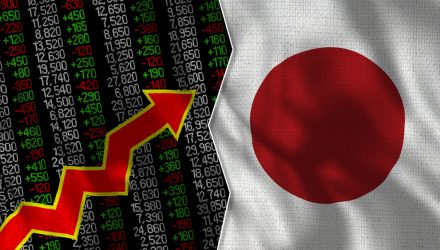Exchange-traded fund (ETF) investors looking to get Japan exposure may want to exercise their due diligence before simply diving into their associated funds. According to the Bank of Japan (BOJ), the nation’s economy is expected to contract 4.7% in fiscal 2020 despite recent signs of gradual recovery from the coronavirus pandemic.
According to a Nikkei Asian Review article, the “estimate, released in a quarterly outlook report, is the median of forecasts from all BOJ policy board members, which ranged from minus 4.5% to minus 5.7%. The range represented a worsening from the April estimate of a contraction of between 3.0% and 5.0%.”
“The downshift reflects a slower-than-expected recovery, both in Japan and overseas,” said Hideo Kumano, chief economist at Dai-ichi Life Research Institute.
Like many nations globally, don’t expect a quick bounce back to normalcy.
“The pace of recovery is expected to be gradual,” said Haruhiko Kuroda, the central bank’s governor, at a news conference after a two-day policy board meeting. The BOJ’s funding assistance to businesses will need to be kept in place for some time, he added.
Kuroda highlighted positive aspects of the economy, saying, “The number of bankruptcies has been limited so far, and unemployment has increased, but not as much as in other countries or after the Lehman crisis,” Kuroda added.
This economic picture puts exchange-traded funds (ETFs) in the spotlight that feature Japan exposure, such as the Goldman Sachs ActiveBeta Japan Equity ETF (GSJY). GSJY seeks to provide investment results that closely correspond to the performance of the Goldman Sachs ActiveBeta® Japan Equity Index.
The fund seeks to achieve its investment objective by investing at least 80% of its assets (exclusive of collateral held from securities lending) in securities included in its underlying index, in depositary receipts representing securities included in its underlying index and in underlying stocks in respect of depositary receipts included in its underlying index, which is designed to deliver exposure to equity securities of Japanese issuers.
Because GSJY is an ActiveBeta® ETF, that means it follows a performance-seeking methodology that aims to select stocks based on well-established attributes of performance while remaining benchmark-aware. As such, factor diversification is achieved with four distinct performance attributes: good value, strong momentum, high quality, and low volatility.
Furthermore, ActiveBeta® ETFs are among the most competitively priced ETFs on the market. For example, the cost of Goldman Sachs’ ActiveBeta® Japan Equity ETF is 25 basis points, compared to the industry average for smart beta ETFs of 48 basis points.
For more information on GSJY, click here.
Additionally, for more market trends, visit ETF Trends.








